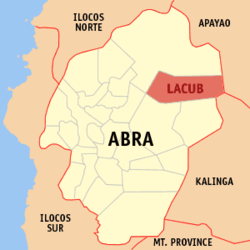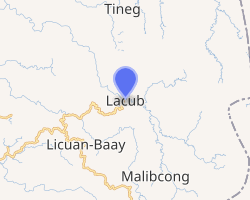Lacub
Lacub, officially the Municipality of Lacub (Ilocano: Ili ti Lacub; Tagalog: Bayan ng Lacub), is a 5th class municipality in the province of Abra, Philippines. According to the 2015 census, it has a population of 3,403 people.[3]
Lacub | |
|---|---|
| Municipality of Lacub | |
 Seal | |
 Map of Abra with Lacub highlighted | |
OpenStreetMap 
| |
.svg.png) Lacub Location within the Philippines | |
| Coordinates: 17°40′N 120°57′E | |
| Country | |
| Region | Cordillera Administrative Region (CAR) |
| Province | Abra |
| District | Lone District |
| Barangays | 6 (see Barangays) |
| Government | |
| • Type | Sangguniang Bayan |
| • Mayor | Nestor B. Bersamina |
| • Vice Mayor | Estelita B. Bersamina |
| • Congressman | Joseph Santo Niño B. Bernos |
| • Electorate | 2,956 voters (2019) |
| Area | |
| • Total | 295.30 km2 (114.02 sq mi) |
| Population (2015 census)[3] | |
| • Total | 3,403 |
| • Density | 12/km2 (30/sq mi) |
| • Households | 647 |
| Economy | |
| • Income class | 5th municipal income class |
| • Poverty incidence | 27.13% (2015)[4] |
| • Revenue (₱) | 73,126,433.43 (2016) |
| Time zone | UTC+8 (PST) |
| ZIP code | 2821 |
| PSGC | |
| IDD : area code | +63 (0)74 |
| Climate type | tropical rainforest climate |
| Native languages | Itneg language Ilocano Tagalog |
Geography
Lacub is located at 17°40′N 120°57′E.
According to the Philippine Statistics Authority, the municipality has a land area of 295.30 square kilometres (114.02 sq mi) [2] constituting 7.09% of the 4,165.25-square-kilometre- (1,608.21 sq mi) total area of Abra.
Barangays
Lacub is politically subdivided into 6 barangays.[5]
| PSGC | Barangay | Population | ±% p.a. | |||
|---|---|---|---|---|---|---|
| 2015[3] | 2010[6] | |||||
| 140109001 | Bacag | 6.6% | 226 | 233 | −0.58% | |
| 140109002 | Buneg | 25.7% | 875 | 827 | 1.08% | |
| 140109003 | Guinguinabang | 7.4% | 251 | 290 | −2.71% | |
| 140109004 | Lan-ag | 12.4% | 422 | 353 | 3.46% | |
| 140109005 | Pacoc | 20.0% | 682 | 571 | 3.44% | |
| 140109006 | Poblacion (Talampac) | 27.8% | 947 | 703 | 5.84% | |
| Total | 3,403 | 2,977 | 2.58% | |||
Climate
| Climate data for Lacub, Abra | |||||||||||||
|---|---|---|---|---|---|---|---|---|---|---|---|---|---|
| Month | Jan | Feb | Mar | Apr | May | Jun | Jul | Aug | Sep | Oct | Nov | Dec | Year |
| Average high °C (°F) | 24 (75) |
26 (79) |
28 (82) |
29 (84) |
29 (84) |
28 (82) |
28 (82) |
27 (81) |
27 (81) |
27 (81) |
26 (79) |
24 (75) |
27 (80) |
| Average low °C (°F) | 16 (61) |
17 (63) |
18 (64) |
20 (68) |
22 (72) |
22 (72) |
22 (72) |
22 (72) |
21 (70) |
20 (68) |
18 (64) |
18 (64) |
20 (68) |
| Average precipitation mm (inches) | 24 (0.9) |
26 (1.0) |
25 (1.0) |
43 (1.7) |
159 (6.3) |
180 (7.1) |
204 (8.0) |
207 (8.1) |
183 (7.2) |
185 (7.3) |
91 (3.6) |
67 (2.6) |
1,394 (54.8) |
| Average rainy days | 8.2 | 8.7 | 10.1 | 13.7 | 22.3 | 24.3 | 25.3 | 23.5 | 22.2 | 16.4 | 14.1 | 12.7 | 201.5 |
| Source: Meteoblue [7] | |||||||||||||
Demographics
| Year | Pop. | ±% p.a. |
|---|---|---|
| 1939 | 1,054 | — |
| 1948 | 944 | −1.22% |
| 1960 | 1,424 | +3.48% |
| 1970 | 1,706 | +1.82% |
| 1975 | 1,927 | +2.47% |
| 1980 | 2,038 | +1.13% |
| 1990 | 2,326 | +1.33% |
| 1995 | 2,202 | −1.02% |
| 2000 | 2,782 | +5.14% |
| 2007 | 3,050 | +1.28% |
| 2010 | 2,977 | −0.88% |
| 2015 | 3,403 | +2.58% |
| Source: Philippine Statistics Authority[3][6][8][9] | ||
In the 2015 census, Lacub had a population of 3,403.[3] The population density was 12 inhabitants per square kilometre (31/sq mi).
gollark: Go visit SCP-055.
gollark: Fine. We will pay you 0.5 melons per day in addition to your current pay.
gollark: Invalid POTAT-O5 credentials. Deploying MTF α-1 to your location. Deploying memetic kill agents. Deploying orbital lasers. Deploying apeirohazards.
gollark: The summary I can give to those of level-0 clearance is that LyricLy [DATA EXPUNGED] because of [REDACTED].
gollark: [INPUT POTAT-O5 CREDENTIALS]
References
- "Municipality". Quezon City, Philippines: Department of the Interior and Local Government. Retrieved 31 May 2013.
- "Province: Abra". PSGC Interactive. Quezon City, Philippines: Philippine Statistics Authority. Retrieved 12 November 2016.
- Census of Population (2015). "Cordillera Administrative Region (CAR)". Total Population by Province, City, Municipality and Barangay. PSA. Retrieved 20 June 2016.
- "PSA releases the 2015 Municipal and City Level Poverty Estimates". Quezon City, Philippines. Retrieved 12 October 2019.
- "Municipal: Lacub". PSGC Interactive. Quezon City, Philippines: Philippine Statistics Authority. Retrieved 8 January 2016.
- Census of Population and Housing (2010). "Cordillera Administrative Region (CAR)". Total Population by Province, City, Municipality and Barangay. NSO. Retrieved 29 June 2016.
- "Lacub: Average Temperatures and Rainfall". Meteoblue. Retrieved 25 April 2020.
- Censuses of Population (1903–2007). "Cordillera Administrative Region (CAR)". Table 1. Population Enumerated in Various Censuses by Province/Highly Urbanized City: 1903 to 2007. NSO.
- "Province of Abra". Municipality Population Data. Local Water Utilities Administration Research Division. Retrieved 17 December 2016.
This article is issued from Wikipedia. The text is licensed under Creative Commons - Attribution - Sharealike. Additional terms may apply for the media files.